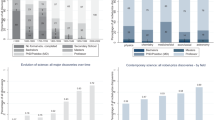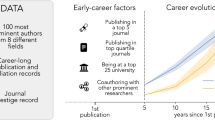Abstract
I examine whether or not new scientific specialties present young scientists with better opportunities to make significant discoveries than established specialties by examining a series of significant discoveries in the first 22 years of the field of bacteriology. I found that it was middle aged scientists, not young scientists, who were responsible for a disproportionate number of significant discoveries. I argue that in order to make significant discoveries scientists need to work their way into the center of the social network of a scientific research community. Only then will they have access to the material and social resources necessary to make such discoveries.
Similar content being viewed by others
References
K. B. WRAY, Is science really a young man.s game? Social Studies of Science, 33 (2003) 137–149.
T. S. KUHN, Structure of Scientific Revolutions, 3rd Edition, University of Chicago Press, Chicago, 1996.
H. ZUCKERMAN, Scientific Elite: Nobel Laureates in the United States, Transaction Publishers, New Brunswick, 1996.
H. W. MENARD, Science: Growth and Change, Harvard University Press, Cambridge, 1971.
S. COLE, Age and scientific performance, American Journal of Sociology, 84 (1979) 958–977.
T. S. KUHN, The Road since Structure, University of Chicago Press, Chicago, 2000.
S. S. HUGHES, The Virus: A History of the Concept, Heinemann Educational Books, London, 1977, pp. 7–8.
D. DE S. PRICE, Little Science, Big Science... and Beyond, Columbia University Press, New York, 1986.
H. C. LEHMAN, Age and Achievement, Princeton University Press, Princeton, 1953.
W. DENNIS, Creative productivity between the ages of 20 and 80 years, Journal of Gerontology, 21 (1966) 1–8.
W. DENNIS, Age and productivity among scientists, Science, 123 (1956) 724–725.
W. D. GARVEY, K. TOMITA, Continuity of productivity by scientists in the years 196871, Science Studies, 2 (1972) 379–383.
A. E. BAYER, J. E. DUTTON, Career age and researchprofessional activities of academic scientists: Test of alternative nonlinear models and some implications for higher education faculty policies, Journal of Higher Education, 48 (1977) 259–282.
N. STERN, Age and achievement in mathematics: A casestudy in the sociology of science, Social Studies of Science, 8 (1978) 127–140.
R. L. HELMREICH, J. T. SPENCE, W. L. THORBECKE, On the stability of productivity and recognition, Personality and Social Psychology Bulletin, 7 (1981) 516–522.
R. OVER, Is age a good predictor of research productivity? Australian Psychologist, 17 (1982) 129–139.
D. K. SIMONTON, Age and creativity: Nonlinear estimation of an information processing model, International Journal of Aging and Human Development, 29 (1989) 23–37.
D. K. SIMONTON, Creative productivity and age: A mathematical model based on a twostep cognitive process, Developmental Review, 3 (1983) 97–111.
D. K. SIMONTON, Creative productivity: A predictive and explanatory model of career trajectories and landmarks, Psychological Review, 104 (1997) 66–89.
K. HORNER, J. P. RUSHTON, P. A. VERNON, The relation between aging and research productivity of academic psychologists, Psychology of Aging, 1 (1986) 319–324.
S. KANAZAWA, Why productivity fades with age: The crimegenius connection, Journal of Research in Personality, 37 (2003) 257–272.
D. L. HULL, P. D. TESSNER, A. M. DIAMOND, Planck’s Principle, Science, 202 (17 November 1978) 717–723.
H. G. MC CANN, Chemistry Transformed: The Paradigmatic Shift from Phlogiston to Oxygen, Norwood: Ablex, Norwood, 1978.
M. H. NITECKI, J. L. LEMKE, H. W. PULLMAN, M. E. JOHNSON, Acceptance of plate tectonic theory by geologists, Geology, 6 (1978) 661–664.
A. M. DIAMOND, Age and acceptance of cliometrics, The Journal of Economic History1, 40 (1980) 838–841.
J. A. STEWART, Drifting continents and colliding interests: A quantitative application of the interests perspective, Social Studies of Science, 16 (1986) 261–279.
P. MESSERI, Age differences in the reception of new scientific theories: The case of plate tectonics theory, Social Studies of Science, 18 (1988) 91–112.
M. RAPPA, K. DE BACKERE, Youth and scientific innovation: The role of young scientists in the development of a new field, Minerva, 31 (1993) pp120}.
D. CRANE, Invisible Colleges: Diffusion of Knowledge in Scientific Communities, University of Chicago Press, Chicago, 1972.
D. K. SIMONTON, Social context of career success and course for 2,026 scientists and inventors, Personality and Social Psychology Bulletin, 18 (1992) 452–463.
D. K. SIMONTON, Leaders of American psychology, 1879.1967: Career development, creative output, and professional achievement, Journal of Personality and Social Psychology, 62 (1992) 5–17.
H. D. WHITE, B. WELLMAN, N. NAZER, Does citation reflect social structure: Longitudinal evidence from the.Globenet. interdisciplinary research group, Journal of the American Society for Information Science and Technology, 55 (2004) 111–126.
D. L. HULL, Science as a Process: An Evolutionary Account of the Social and Conceptual Development of Science, University of Chicago Press, Chicago, 1988.
M. BIAGIOLI, Galileo Courtier: The Practice of Science in the Culture of Absolutism, University of Chicago Press, Chicago, 1993.
S. SHAPIN, A Social History of Truth: Civility and Science in Seventeenth Century England, University of Chicago Press, Chicago, 1994.
K. KNORR CETINA, Epistemic Cultures: How the Sciences Make Knowledge, Harvard University Press,1999.
J. R. COLE, Fair Science: Women in the Scientific Community, The Free Press, New York, 1979.
Author information
Authors and Affiliations
Corresponding author
Rights and permissions
About this article
Cite this article
Wray, K.B. An examination of the contributions of young scientists in new fields. Scientometrics 61, 117–128 (2004). https://doi.org/10.1023/B:SCIE.0000037367.99073.bb
Issue Date:
DOI: https://doi.org/10.1023/B:SCIE.0000037367.99073.bb




